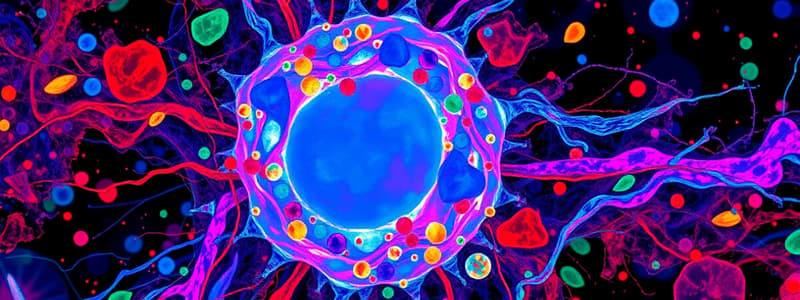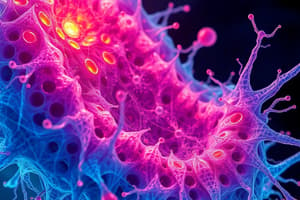Podcast
Questions and Answers
What is the primary function of the nucleus in a cell?
What is the primary function of the nucleus in a cell?
- Energy storage
- Control cell activities (correct)
- Transport materials
- Protein synthesis
Which type of microscope utilizes a beam of electrons for magnification?
Which type of microscope utilizes a beam of electrons for magnification?
- Scanning electron microscope
- Compound microscope
- Electron microscope (correct)
- Light microscope
What is the total magnification power if the ocular lens is 10x and the objective lens is 50x?
What is the total magnification power if the ocular lens is 10x and the objective lens is 50x?
- 1000 times (correct)
- 200 times
- 1500 times
- 500 times
Which of the following is a characteristic of prokaryotic cells?
Which of the following is a characteristic of prokaryotic cells?
What is the role of lysosomes in a cell?
What is the role of lysosomes in a cell?
Which structure is responsible for cellular respiration and ATP formation?
Which structure is responsible for cellular respiration and ATP formation?
What is the primary function of the endoplasmic reticulum in a cell?
What is the primary function of the endoplasmic reticulum in a cell?
Which of the following pairs correctly identifies the two types of endoplasmic reticulum?
Which of the following pairs correctly identifies the two types of endoplasmic reticulum?
What is the role of ribosomes within a cell?
What is the role of ribosomes within a cell?
Apoptosis is primarily important for which developmental process?
Apoptosis is primarily important for which developmental process?
What is a primary distinction between prokaryotic and eukaryotic cells?
What is a primary distinction between prokaryotic and eukaryotic cells?
Which of the following accurately describes the Scanning Electron Microscope (SEM)?
Which of the following accurately describes the Scanning Electron Microscope (SEM)?
Which organelle is responsible for the majority of energy storage within a cell?
Which organelle is responsible for the majority of energy storage within a cell?
What is the primary function of the Golgi Complex in cellular biology?
What is the primary function of the Golgi Complex in cellular biology?
Which component within the cell is classified as an organelle that handles waste and damaged organelles?
Which component within the cell is classified as an organelle that handles waste and damaged organelles?
Flashcards are hidden until you start studying
Study Notes
Cell Basics
- Cells are the fundamental units that compose all organisms.
- All living organisms consist of cells; they arise from pre-existing cells.
Microscopes
- Microscopes are used to observe cells and simple organisms.
- Types of microscopes include:
- Light Microscope: Uses light beams for visualization.
- Electron Microscope: Utilizes electron beams, magnification up to 1,000,000 times.
- Scanning Electron Microscope (SEM): Evaluates cell surface, similar to a light microscope but uses oil to enhance magnification (up to 2000 times).
Magnification Calculation
- Total magnification = Magnifying power of objective lens x Magnifying power of ocular lens.
- Example: Eye lens power of 10 and objective lens power of 100 results in a magnification of 1000 times.
Cell Types
-
Prokaryotic Cells:
- Size: Less than 10 µm.
- Includes only bacteria and archaea.
- Lack a nucleus and membrane-bound organelles.
- Possess smaller ribosomes and a single circular chromosome.
-
Eukaryotic Cells:
- Include animals, plants, protists, and fungi.
Nucleus Functions
- Controls cell activities including cell reproduction and heredity.
Cytoplasm Function
- Acts as a medium to transport cell organelles.
Mitochondria Functions
- Contain enzymes for cellular respiration.
- Responsible for ATP production and energy storage.
Endoplasmic Reticulum (ER)
- Transports materials within the cell.
- Types of ER:
- Rough ER: Contains ribosomes attached for protein synthesis.
- Smooth ER: Lacks ribosomes.
Ribosomes Function
- Serve as the site for protein synthesis and are composed of RNA.
- Aggregation of ribosomes is known as polysome.
Lysosomes Function
- Contain digestive enzymes that remove damaged organelles and foreign objects.
- Involved in apoptosis (programmed cell death) which is essential for multicellular organism development.
Golgi Complex Function
- Packages proteins and waste into vesicles for excretion.
Cell Basics
- Cells are the fundamental units that compose all organisms.
- All living organisms consist of cells; they arise from pre-existing cells.
Microscopes
- Microscopes are used to observe cells and simple organisms.
- Types of microscopes include:
- Light Microscope: Uses light beams for visualization.
- Electron Microscope: Utilizes electron beams, magnification up to 1,000,000 times.
- Scanning Electron Microscope (SEM): Evaluates cell surface, similar to a light microscope but uses oil to enhance magnification (up to 2000 times).
Magnification Calculation
- Total magnification = Magnifying power of objective lens x Magnifying power of ocular lens.
- Example: Eye lens power of 10 and objective lens power of 100 results in a magnification of 1000 times.
Cell Types
-
Prokaryotic Cells:
- Size: Less than 10 µm.
- Includes only bacteria and archaea.
- Lack a nucleus and membrane-bound organelles.
- Possess smaller ribosomes and a single circular chromosome.
-
Eukaryotic Cells:
- Include animals, plants, protists, and fungi.
Nucleus Functions
- Controls cell activities including cell reproduction and heredity.
Cytoplasm Function
- Acts as a medium to transport cell organelles.
Mitochondria Functions
- Contain enzymes for cellular respiration.
- Responsible for ATP production and energy storage.
Endoplasmic Reticulum (ER)
- Transports materials within the cell.
- Types of ER:
- Rough ER: Contains ribosomes attached for protein synthesis.
- Smooth ER: Lacks ribosomes.
Ribosomes Function
- Serve as the site for protein synthesis and are composed of RNA.
- Aggregation of ribosomes is known as polysome.
Lysosomes Function
- Contain digestive enzymes that remove damaged organelles and foreign objects.
- Involved in apoptosis (programmed cell death) which is essential for multicellular organism development.
Golgi Complex Function
- Packages proteins and waste into vesicles for excretion.
Studying That Suits You
Use AI to generate personalized quizzes and flashcards to suit your learning preferences.



